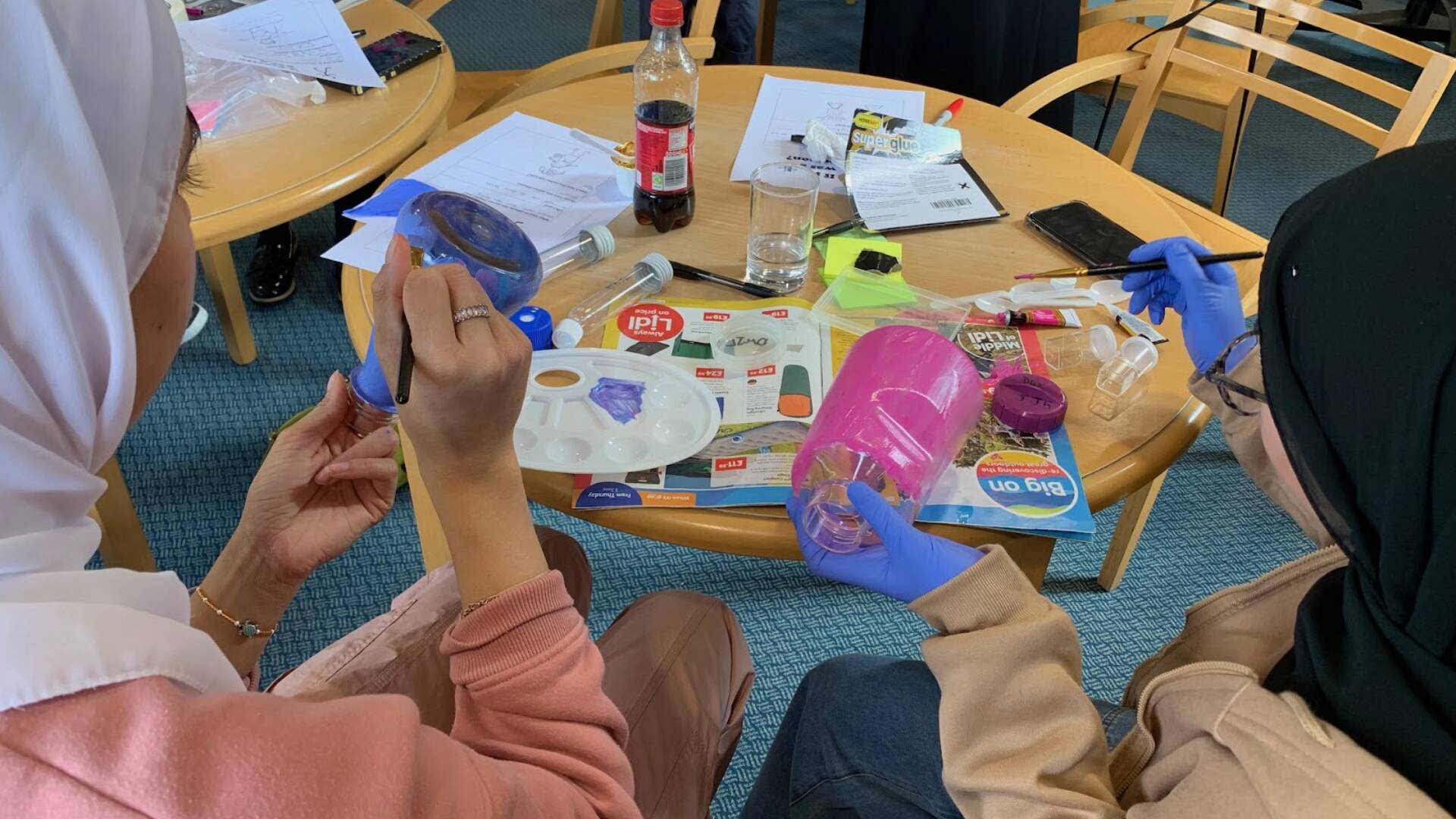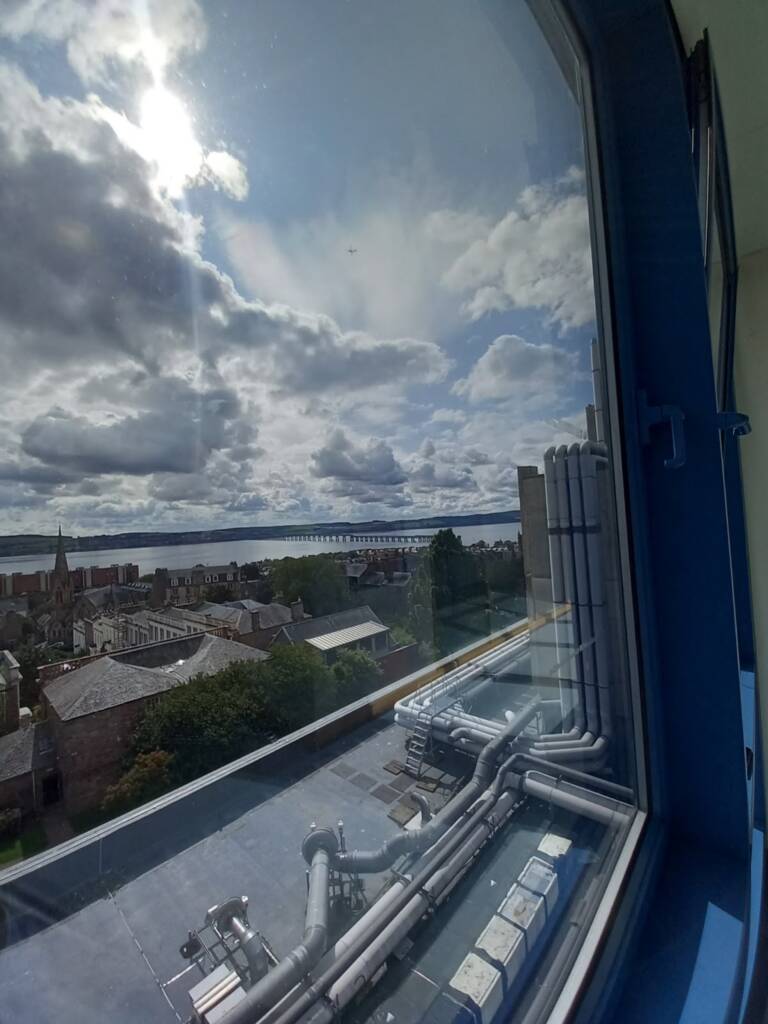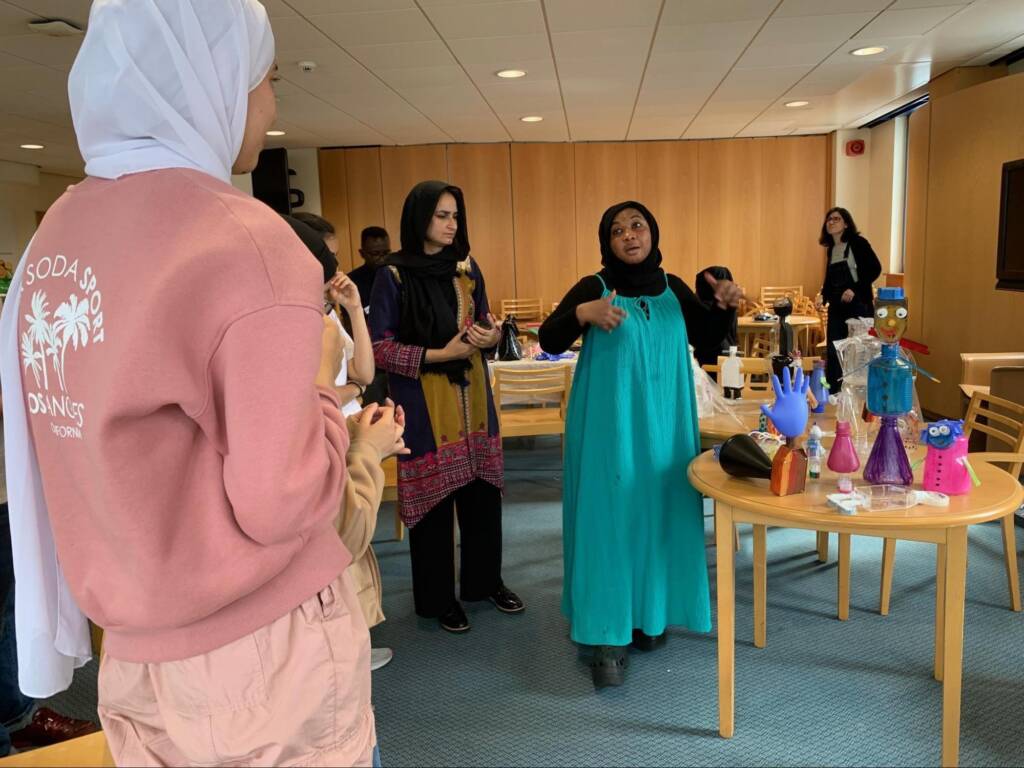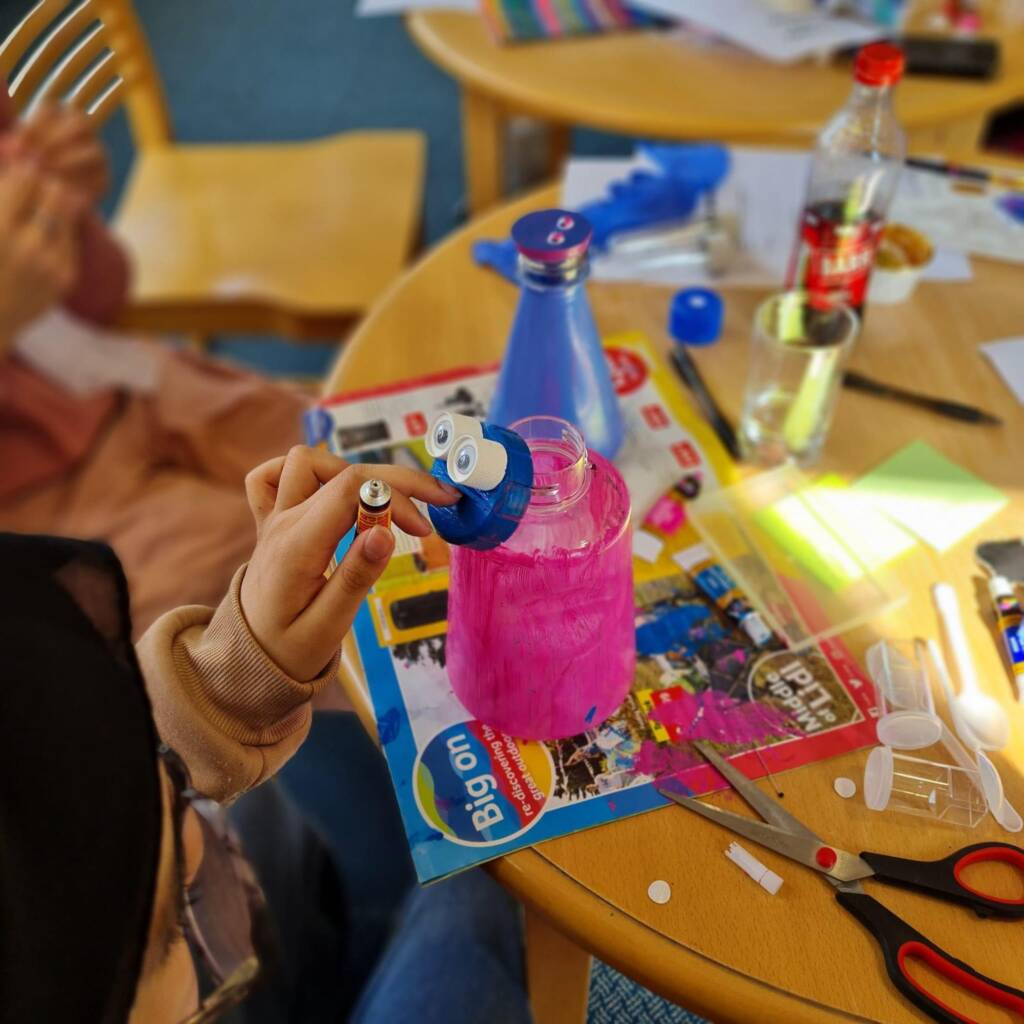
19.10.23

For the past few months, CULTIVATE Creative Practitioner Vinishree Verma has been leading a series of creative workshops exploring climate action with diverse groups from across Dundee.
Self-described observer, dreamer and passionate scribbler Wuraola Young, joined one such workshop at the University of Dundee’s School of Life Sciences learning about plastic as both a blessing and a threat.
For this blog, Wuraola shares her experiences of the workshop and reflects on the invaluable connections between science and art that could lead to meaningful change.
I am not sure if I should be angry or amused.
How can I be soaked through to my denim shirt even though I am wearing what should be a waterproof jacket in rain that is mercifully not heavy?
It had chosen to pour down on myself and another stranger, completely unannounced. We walked together, boots splashing water puddles and car tires making swishing sounds as rubber ran over wet asphalt.
Isn’t it ironic that just moments ago I was taking pictures of the Dundee Law, rising into the skyline on a backdrop of beautiful blue skies. Moments before then I had been stopped in my tracks by a breathtaking view of the entire stretch of the Tay bridge through the windows lining the corridor.
I had gone back to grab my phone, who knows, I may never be in this building, walking along this very corridor again. I took several pictures and drank in the view.
“Just genius!” I thought to myself.
Kudos indeed to the architects who positioned the School of Life Sciences, to capture these views.


I could space out here all day if allowed to.
I drew myself back from my reverie and returned to the workshop. A tiny corner of my mind wondered if I could find a reason to work here just so I could drink in the view all the time. But alas! I am no life scientist and still adamant about having had enough of academia after my MSc. For someone who’d scuffed at the ivory towers for so long, I was humbled by the amount of work all those who walked the path had really put in.
Today though, I was lucky to be in the same room as people whose life’s work is to find answers to problems that plague humanity. Researchers working in Life Sciences look to eradicate diseases, create medicines, protect endangered species, and so much more.
The ongoing workshop was about creatively upcycling plastic, organised by CULTIVATE and the School of Life Sciences at the University of Dundee.
After getting lost and arriving almost fifteen minutes late (I am constantly surprised by how big Dundee is and wonder why the locals ‘insist’ it’s a small city), I joined a group of five people waiting in the lobby and we were all escorted by Elisa to the café to join the rest of the group. Even though I’d been a student at the University of Dundee until just last September, I’d never been in this building.
Today, like the previous workshops, I came open to experience whatever was planned. Sometimes you just have to allow yourself to be guided, to have experiences you didn’t know you needed; I’ve found it makes for a richer life.
Within the first hour, I learned that even though life scientists are doing crucial work to save and move humanity forward, there is also an inevitable downside to the work they do.
They need tons of energy to preserve samples. Air conditioning, cooling, or freezing units run 24 hours a day, 7 days a week, year-round, year after year. Then there was the staggering amount of plastic that came from the science equipment like beakers, funnels, petri dishes, and more. Add to that, the tonnes of plastic wraps for each piece to keep them sterile.
If we hadn’t been shown a sample of the quantity of waste generated per day, I would not have been able to quantify it. But believe me when I say, that even after we saw it, I found it hard to wrap my head around how much would be generated in a week, across multiple similar labs in the UK alone.
Here’s what Elisa told us:
“I would say that every month we, produce around 100kg of soft plastic wrappings, equivalent to a baby elephant, and 5 tonnes of plastic rubbish or an ambulance. We do recycle around 200kg every month – same as a bottlenose dolphin!”
There’s no doubt that now is the time to find lasting solutions.
One could almost excuse these scientists; they are doing vital work, acknowledging the waste problem, and seeking solutions to it. But the concern with a single-use plastic catastrophe is that many companies still use an inordinate amount for obviously trivial things.
I mean can someone please explain why a single banana needs a plastic wrap? Or more confounding, a coconut?
A COCONUT as it came from nature in a shrink wrap?! Why?
On the flip side, I learned of the ingenious re-use of plastic. An example is the delightful chandelier made with recycled coloured plastic bottles on display at the McManus Museum here in Dundee. Another is bottles filled up with mud and stacked up to make the walls of a small building. Also mentioned were old plastic bottles cut in half and the top part converted to a funnel to use for pouring paraffin from kegs, or perforated and used as a sieve or watering can.

After lunch, was more fun. We got to get our hands dirty creating something from all the plastic around us.
I must admit I was 100% stumped for ideas for over half an hour.
The ideas came flooding through my mind a good 24 hours after the workshop. It was as though everywhere I turned, there was potential for what the different bottles I’d seen in the workshop could do. From upcycling to flower vases, to being painted beautiful neon colours and used as garden lamps with LED lights inside them. Refill bottles for cosmetics, a paper weight (this is my spin on the mud-filled bottles), or filling bottles up with coloured stones and used for home-deco.
Ideas are flighty interesting things. If you dare to command them, they flee from you, but if you allow your mind to wander, they come like a willing lover.
I did manage to create something that day though but what was most fascinating were the stories and characters of each work.
From ten-year-old twins to three grandmas and everyone in between, they had made a persona out of plastic using the waste from the lab and shared their thoughts as to who plastic would be if it were a person.

I’d wager I am not the only one being visited by ideas of how the byproducts of the experiments from the School of Life Sciences can be upcycled.
It is a marvellous way to get people who’d otherwise not even think about the insane plastic waste problem we have (like me, I was so not clued into how serious the challenge is) to start from their own small corner of the world and make changes.
Is there anywhere else in the world where a prestigious faculty like the School of Life Sciences at the University of Dundee has been bold enough to deliberately create an overlap between Art and Science?
Just imagine for a moment if the mass of people who love creative art, from green horns to aficionados, synergised with scientists to turn waste into beautiful works of art.
I’ve never understood why both disciplines turn their nose up at the other. Surely the world would be many shades grayer without art – no breathtaking architecture, literature, or paintings by the da Vincis, Rumis, Hemmingsways, and Picassos of this world.
And without science, we’d just not have gotten out of the stone age, would we? Thank God the Flemings, Maries Curies and Al-Khwarizmis shared their genius with us. What would our world be like without the healing benefits of penicillin, the impact of electricity and the technological advancement enabled by algebraic and algorithmic computations?
No. I think we’d not have even made it this far.
As we concluded the session with each Plastic Person story, I could feel the upbeat energy in the room. It had shifted from most of us bemoaning being out early on a Saturday morning, to excited chatter about our work.
Making time for creativity aka ‘playing’ is something we must do. Why? Because it recharges us. And it is from our creativity we get to find solutions to challenges all around us.
Many a wonderful discovery happened ‘accidentally’; while attempting to create one thing, people stumbled on another. Think Post-it notes, the microwave, X-rays and – wait for it – chocolate chip cookies, popsicles and potato crisps!
It was such a satisfying day for me. I had plenty to chew on.
As we were escorted back down to the lobby to exit the building, I could hear the thundering of raindrops on the roof.
“Is that rain?” I asked.
“Yes,” said Elisa.
“But it’s been such a clear sunny day till moments ago!” I exclaimed.
I don’t mind the rain, but I so do not like the cold.
She reassured me that the rain is usually louder inside the building than it is outside. Oh well!
So, into the rain I walked with this stranger from the workshop. I knew her name though, I’d seen it on the tags we’d all worn through the day.
She was a student of DJCAD, she told me, and was familiar with the School of Life Sciences because she’d been working with someone there.
“Ah! The Marriage of Art and Science.” I mused.
Thanks to her I didn’t need to fiddle with Google Maps to find my way to the nearest bus stop. The darned thing had gotten me lost that morning already.
As we splish-splashed through the rain, we talked about the workshop, schooling, and work. In under fifteen minutes, we moved from being strangers, maybe not to being friends, but a pair of humans who had shared time and a walk in the rain.
If nothing at all, the next time we meet we’d ask one another if we got home okay and how we were getting on with this, that, or the other.
How could I be mad at the rain? It had been a beautiful day.
I was soaked through my jacket, but I figured it was a small price to pay for the part I played in why it would be raining on a day that ordinarily should be ‘summery’.
Indeed, we all are hit by the effects of how we choose to care, or not care about the climate.
With huge thanks to Wuraola for sharing her experience!
Join us to celebrate the work created and questions raised by the CULTIVATE groups, and to explore the climate crisis through their eyes – Dear Earth: Creating Hope in a Climate Crisis on 28-29 Oct, in Dundee, and “It’s the End!” Project Echo Final Exhibition on 4 Nov, in Perth.
The session took place at the University of Dundee’s School of Life Sciences. We were joined by Dr. Elisa Garcia-Wilson from the School’s MRC PPU, Dr. Vanesa Alvarez from Molecular, Cell, and Developmental Biology, and Ali Floyd, Public Engagement Manager for the Wellcome Centre for Anti-Infectives Research.
CULTIVATE is a Culture Collective leadership programme led by Creative Dundee. The programme works with local creative practitioners to place creativity at the heart of climate justice, developing action with communities across the Tay region. Discover more about CULTIVATE and meet our second cohort of Creative Practitioners.

If you would like to support us in creating even better content, please consider joining or supporting our Amps Community.